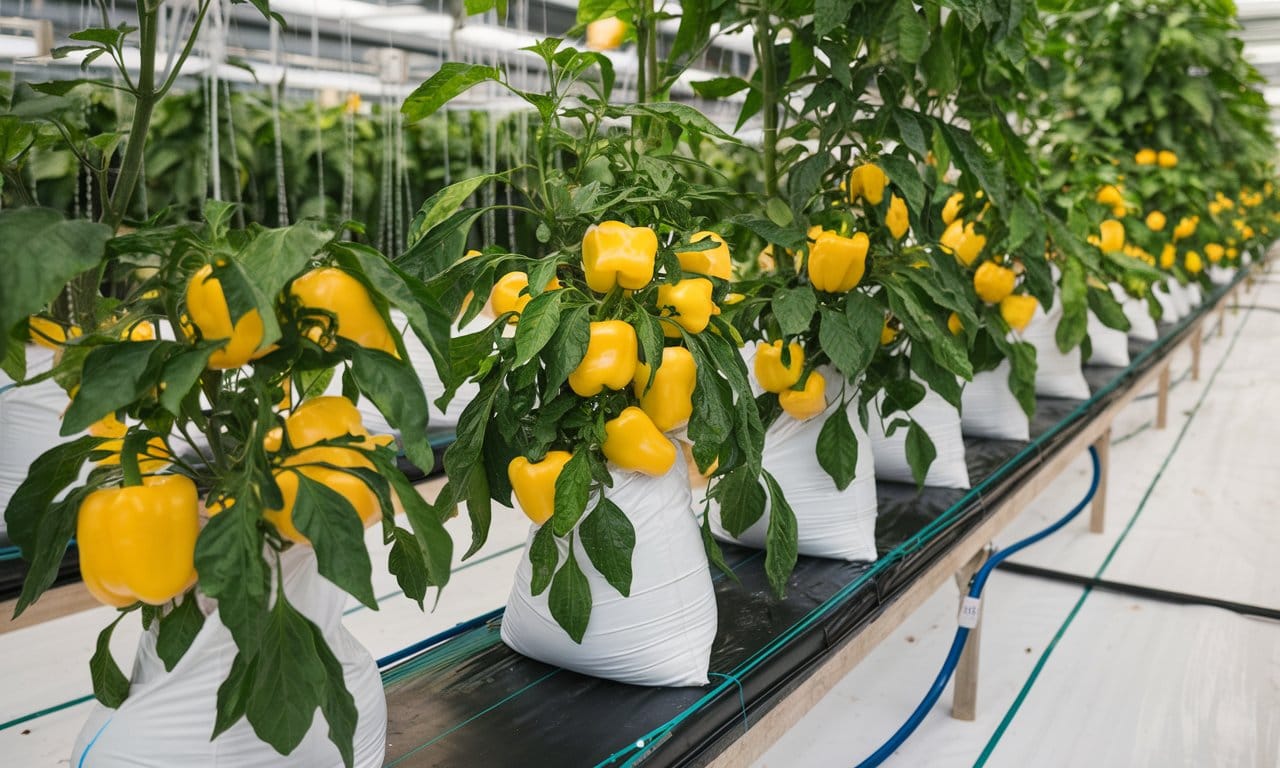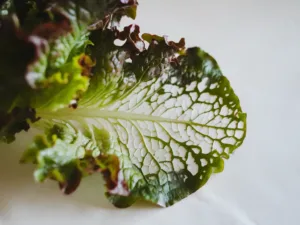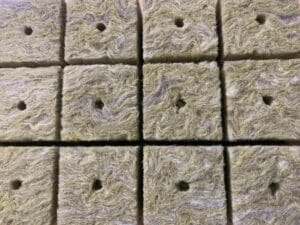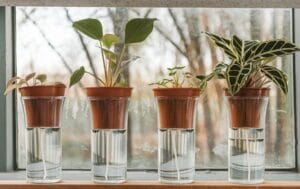If you love peppers and want to have fresh, crunchy ones at your fingertips, hydroponic cultivation might be just what you need. Hydroponics, the method of growing plants without soil, is not only space-saving but also gives you control over nutrients and water supply. This often leads to faster growth rates and higher yields compared to traditional soil cultivation. And the best part: you can grow peppers all year round, regardless of the weather and season.
Another advantage of hydroponics is that you avoid many typical garden problems like weeds and soil-borne diseases. Instead, you can focus entirely on the healthy growth of your plants. Peppers, whether sweet or spicy, thrive particularly well in this environment. Controlling light, water, and nutrients helps you create perfect conditions for robust plants. So, if you’re ready to harvest your own peppers—faster than you might think—let’s get started!
Choosing Varieties: Which Pepper Varieties Are Best for Hydroponics?
Peppers come in many shapes and colors, from mild and sweet to hot and fiery. But not all varieties are equally suited for hydroponics. Some grow compactly and are ideal for indoor cultivation, while others need space to fully develop. The right choice of variety depends on your space, taste, and cultivation goals.
- Compact Varieties for Limited Space: If you have limited space, smaller pepper varieties like “Mini Bell” or “Sweet Banana” are perfect. These varieties are not only space-saving but also reliably productive and relatively easy to care for. They are also ideal for hydroponics beginners.
- Large, High-Yield Varieties: If you have a bit more space and want to harvest larger fruits, varieties like “California Wonder” or “Corno di Toro” are the right choice. These are known for their large, meaty fruits and intense flavor. However, they require more space and stable support to bear their weight.
- Spicy Pepper Varieties for the Bold: If you like it hot, “Jalapeño” or “Cayenne” might be just right for you. These varieties are not only eye-catching in the garden but also add a fiery touch to your dishes. Note that spicier varieties often require more light and warmth to reach their full potential.
Suitable Hydroponic Systems: Which System Suits Peppers?
Peppers are relatively adaptable and can be grown in various hydroponic systems. However, depending on how much space and resources you have, some systems are particularly well-suited.
- Deep Water Culture (DWC): This system is particularly popular because it is easy to set up and maintain. The plant roots hang directly in a nutrient solution, providing them with a continuous supply of water and nutrients. DWC is ideal for larger pepper varieties as the plants stand stable in net pots and have enough space for root growth.
- Nutrient Film Technique (NFT): In this system, a thin layer of nutrient solution continuously flows over the plant roots. NFT is space-saving and efficient but is more suitable for smaller or compact pepper varieties. Larger plants often require additional support to remain stable.
- Ebb and Flow System: Here, the plant roots are held in a substrate that is regularly flooded with nutrient solution and then drained. This system is very flexible and suitable for both small and large pepper varieties. It offers a good balance between aeration and nutrient supply.
If you’re just starting out with hydroponics, DWC is probably the easiest way to go. However, if you have some experience and want to optimize your system, it might be worth considering other options.
How to Successfully Grow Your Pepper Seedlings
Growing your pepper seeds is a crucial step that lays the foundation for strong and healthy plants. In hydroponics, this process often begins in a seedling tray or with seedling cubes, as peppers take a bit longer to germinate than other plants. With the right preparation, you can easily get started.
- Select and Prepare Seeds: Start by getting high-quality pepper seeds. Make sure the seeds are fresh and well-stored, as peppers tend to germinate slower or less reliably with older seeds. You can soak the seeds overnight in lukewarm water to speed up germination—this softens the hard seed coat and increases the germination rate.
- Germination in Seedling Trays or Cubes: Once the seeds are prepared, place them in a germination tray or directly in seedling cubes (e.g., rock wool or coconut fiber). Keep the substrate evenly moist but not wet to avoid mold formation. The ideal germination temperature for peppers is around 25 to 30 degrees Celsius. Pepper seeds require patience—germination can take up to two weeks, so don’t be discouraged if nothing happens after a few days.
- Caring for Seedlings Until Transplanting: Once the seedlings have developed their first leaves, you can transplant them into the hydroponic system. Make sure they get enough light (12–14 hours per day) as peppers need a lot of energy at this stage. Initially, use a weaker nutrient solution so the tender roots are not overwhelmed. In this phase, it’s important to watch for mold or root rot, as moist conditions can attract pests.
With the right care, your seedlings will soon become strong young plants ready to move into a larger hydroponic system.
What is the Best Substrate for Peppers in Hydroponics?
The substrate is a crucial factor in hydroponic cultivation as it stabilizes the roots of your pepper plants while ensuring adequate air supply. Although soil is not used in hydroponics, pepper plants still need a medium that retains moisture and supports the roots.
Here are some of the best substrates for peppers in hydroponics:
- Rock Wool: Rock wool is one of the most commonly used substrates in hydroponics. It retains water very well and provides excellent aeration for the roots. The downside is that it can decompose if not properly treated. However, rock wool is perfect for germination and the initial phase as it evenly distributes moisture and creates a stable environment.
- Perlite: Perlite is a lightweight, porous substrate made from volcanic rock. It has excellent drainage and provides good oxygen supply to the roots. However, it retains less water than rock wool, making it better suited for plants that prefer slightly drier conditions.
- Coconut Fiber: Coconut fiber is an eco-friendly option made from the husk of coconuts. It retains both water and air very well, making it an excellent substrate for peppers. Another advantage is that coconut fiber is biodegradable and can be recycled after use.
The best substrate for you depends on your hydroponic system and personal preferences. Rock wool and coconut fiber are favorites, but perlite can also be a good addition, especially if you want to improve drainage.
Optimal Temperature and Humidity for Peppers
Peppers originate from warm regions and therefore love warmer temperatures and moderate humidity. The right environmental temperature is crucial for the healthy growth and yield of your plants.
- Temperature: Pepper plants prefer temperatures between 20 and 30 degrees Celsius. During the growth phase, make sure the temperature does not fall below 18 degrees, as this can slow growth. A consistently warm environment is ideal for flowering and fruiting. It can be cooler at night, but the temperature should not drop below 15 degrees.
- Humidity: Peppers thrive best at a humidity level between 50 and 70 percent. Air that is too dry can stress the plant, while too high humidity increases the risk of fungal diseases and mold formation. In a controlled hydroponic environment, you can control humidity through good ventilation and the use of humidifiers or dehumidifiers.
Especially in the cooler months, when you grow peppers indoors, it’s important to keep the temperature constant. Make sure your plants are not in drafts and ensure they receive enough light to compensate for the slightly lower temperatures.
How Much Light Does Your Pepper Plant Need?
Pepper plants are true sun lovers and need plenty of light to grow vigorously and develop healthy fruits. In nature, they enjoy hours of sunlight daily, and in hydroponics, you should ensure your plants get enough light.
- Daily Light Requirement: Your pepper plants need at least 12 to 14 hours of light per day. For optimal growth and a bountiful harvest, you can even provide up to 16 hours of light. Especially in the winter months, when natural sunlight is limited, additional light sources are a must.
- Choice of Lighting: LEDs are the first choice when it comes to hydroponic pepper cultivation. They are energy-efficient, generate little heat, and can be adjusted to provide the perfect light spectrum for growth. Make sure the light source is not too far from the plants—the closer they are to the light, the better they can absorb it. HPS lamps (High-Pressure Sodium Lamps) are also popular as they offer strong light output but generate more heat and consume more energy.
- Light Intensity and Spectrum: For the growth phase, pepper plants primarily need blue light, which promotes leaf formation and root growth. In the flowering and fruiting phase, red light is essential to support abundant fruiting. Many modern LED systems offer full-spectrum light that covers both phases and allows you to adjust the lighting individually.
With the right lighting, your pepper plants will grow vigorously and develop healthy, colorful fruits. Make sure they never suffer from a lack of light—this could slow growth or even impair fruiting.
Why the Right Nutrient Balance is Crucial
The pH and EC values (electrical conductivity) are two of the most important factors you need to monitor closely in hydroponic cultivation. They affect how well your plants can absorb nutrients and whether they grow optimally.
- pH Value: The pH value of your nutrient solution should be between 5.5 and 6.5 for pepper plants. In this slightly acidic range, the roots can best absorb nutrients like nitrogen, phosphorus, and potassium. If the pH is too high or too low, it leads to nutrient deficiencies, even if you are using the right fertilizers. Therefore, it’s important to regularly check the pH and adjust it with pH-Up or pH-Down solutions if necessary.
- EC Value: The EC value measures the amount of dissolved nutrients in your hydroponic solution. For pepper plants, the EC value should be between 1.8 and 2.8 mS/cm, depending on the growth phase. In the early growth phase, you should maintain a lower EC value to avoid over-fertilizing the young plants. In the flowering and fruiting phase, however, the EC value can be higher to meet the increasing nutrient needs of the plants.
- Regular Monitoring: One of the most important tasks in hydroponic cultivation is regularly checking these values. It’s worth having a pH and EC meter on hand to ensure your plants always have the best conditions. An incorrect balance quickly leads to problems like nutrient blockages or even root damage.
If you keep these values in check, your pepper plants will be able to absorb all the essential nutrients and grow as healthily as possible. Small deviations can be quickly corrected if you measure regularly and adjust the solution.
These Nutrients Are Essential for Peppers in Hydroponics
To grow vigorously and deliver a bountiful harvest, pepper plants need the right mix of nutrients. In hydroponics, you supply your plants directly through the nutrient solution, so choosing the right fertilizer and dosing is crucial.
- Macronutrients: Peppers primarily need the three main nutrients nitrogen (N), phosphorus (P), and potassium (K), often found in NPK fertilizers. While nitrogen promotes leaf growth and the overall health of the plant, phosphorus is crucial for root development and flower formation. Potassium supports fruit development and helps them become large and robust. A balanced nutrient ratio is essential.
- Micronutrients: In addition to the main nutrients, pepper plants also need a range of micronutrients, such as magnesium, calcium, iron, and zinc. These trace elements are required in small amounts but play a significant role in the overall health of the plant. Magnesium, for example, is crucial for photosynthesis, while calcium strengthens the cell structure.
- Dosage and Fertilization Rhythm: At the beginning of the growth phase, you should use a lighter nutrient solution to avoid overloading the roots. As the plant grows larger, you can gradually increase the concentration, especially in the flowering phase when the nutrient demand is highest. Many hydroponic fertilizers are specifically tailored to the different growth phases and offer you the opportunity to adjust the nutrient supply.
Regularly checking the nutrient solution is important to avoid deficiencies. If the leaves show signs of deficiency (e.g., yellow leaves or deformed fruits), you should act quickly and correct the nutrient balance.
How to Tell When Your Peppers Are Ripe
The moment you’ve been working towards: harvesting your peppers! But how do you know when the fruits are really ripe? Peppers are a fruit that changes color as they ripen—from green to yellow, orange, red, or even purple, depending on the variety. But it’s not just the color that matters; other signs also indicate that your peppers are ready to be harvested.
- Color and Size: Most pepper varieties start green and then ripen to their final color. You can harvest green peppers if you like the slightly bitter taste. However, they reach full ripeness and sweetness only when they have taken on their final color. Also, pay attention to the size—when the fruit has reached its typical shape and size, it is ripe enough for harvest.
- Firmness: In addition to color, the fruit should also be firm and plump. If the pepper yields slightly to pressure, it is ripe and ready to be picked. Soft spots, on the other hand, indicate that the fruit is overripe or has been hanging on the plant for too long.
- Regular Harvesting: Once you notice that a pepper is ripe, you should harvest it to make room for new fruits. This encourages the plant to continue flowering and producing new fruits. Once harvested, you can store the peppers in the refrigerator, where they will stay fresh for a few more days.
Regular harvesting not only ensures a steady supply of fresh peppers but also keeps the plant healthy and productive.
Common Problems and How to Avoid Them
Even though hydroponics offers many advantages, you are not completely protected from diseases and pests. However, some of the most common problems with peppers can be avoided or quickly treated if you stay vigilant and regularly inspect your plants.
- Root Rot: One of the most common problems in hydroponics is root rot, caused by too much moisture and lack of aeration. Symptoms include stunted plants, yellow leaves, and slimy, brown roots. To avoid root rot, ensure that the root system is adequately aerated and not sitting in stagnant nutrient solution. An air stone in the reservoir can work wonders by increasing oxygen levels.
- Aphids and Spider Mites: Although insects are less of a problem in indoor hydroponics, aphids and spider mites can sometimes appear, especially if the air is too dry. Both pests suck the sap from the leaves and can significantly impair the plant’s growth. Regularly checking the leaves and using beneficial insects like ladybugs or biological insecticides can help keep these pests at bay.
- Blossom End Rot: This disease often occurs in peppers when there is a calcium deficiency. You can recognize it by dark, rotten spots at the lower end of the fruit. To prevent blossom end rot, ensure that the pH value is stable and sufficient calcium is present in the nutrient solution. Adjusting watering times often helps improve nutrient transport.
Attentive care and regular inspections of your pepper plants will help you detect diseases and pests early and act promptly. This keeps your harvest healthy and abundant.
Your Recipe for Success with Hydroponic Peppers
Growing peppers in hydroponics requires a bit of patience, but the reward is huge—crisp, juicy, and flavorful peppers that you’ve grown yourself. From choosing the right varieties to optimal care and harvesting, you’ve now learned all the essential steps. Controlling light, nutrients, and environment gives you the opportunity to get the best out of your plants and even enjoy fresh peppers all year round.
Whether you’re a beginner or have some experience in hydroponic cultivation, with the right techniques and a little attention, you’ll soon be celebrating your first successes. So, what are you waiting for? Start your next hydroponic adventure and look forward to a bountiful pepper harvest!







